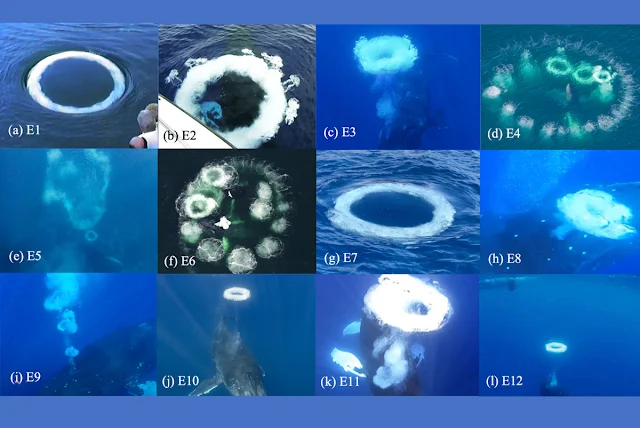A mesmerizing new study suggests that humpback whales may be using underwater bubble rings not just for play or hunting, but as a possible form of communication—perhaps even directed at human onlookers.
Humpback whales (Megaptera novaeangliae) are famously known for their spiral “bubble nets,” used as a hunting strategy to corral prey. But bubbles, it turns out, are far more versatile in whale behavior. They can be playful, flirtatious, or even aggressive, depending on the context.
The focus of this study is on a more peculiar kind of bubble display: perfect, doughnut-shaped rings, reminiscent of what biologist Roger Payne once described as “madly spinning doughnut-shaped clouds that look like giant smoke rings about three feet in diameter, rising swiftly to the surface.”
To investigate this phenomenon, an international team of biologists and photographers analyzed video and photographic footage of humpback whales producing these circular bubble rings. The material was captured both underwater—by swimmers or from boats—and from above, using drones, aircraft, or boat-based cameras.
This variety of perspectives helped the researchers contextualize the whales’ behavior. Was it directed at other whales, or possibly aimed at the humans observing them?
The team documented 12 separate episodes involving the production of 39 bubble rings by 11 individual whales. Interestingly, 10 of the 12 instances occurred near boats or human swimmers, and in six episodes, more than one whale was present.
Despite these close encounters, the whales showed no signs of hostility—toward each other or the humans. “There was no evidence of agonism toward conspecifics or aggression toward boats or swimmers in any of the ring episodes,” the researchers reported.
In fact, the opposite seemed true: in eight out of nine cases, the bubble-blowing whales voluntarily approached boats or swimmers—unless they were actively feeding.
This isn't the first time whales have exhibited seemingly playful behavior near humans. Many species have been observed blowing bubbles or exhaling near vessels, often interpreted as friendly or curious gestures. The deliberate formation of bubble rings may be yet another example of whales initiating interspecies interaction—akin to how humans might play with other animals.
While this opens up exciting possibilities about whale-to-human communication, the researchers emphasize that much more data is needed to understand the intent behind these bubble displays.
"Whatever the reason for their creation, maintaining vigilance in the field will help elucidate the frequency and function of bubble rings," the authors write.
Whether playful, communicative, or both, bubble rings could hold deeper meaning for humpback whales—and perhaps offer us a glimpse into their complex social lives and capacity for interspecies connection.
The study is published in Marine Mammal Science.

